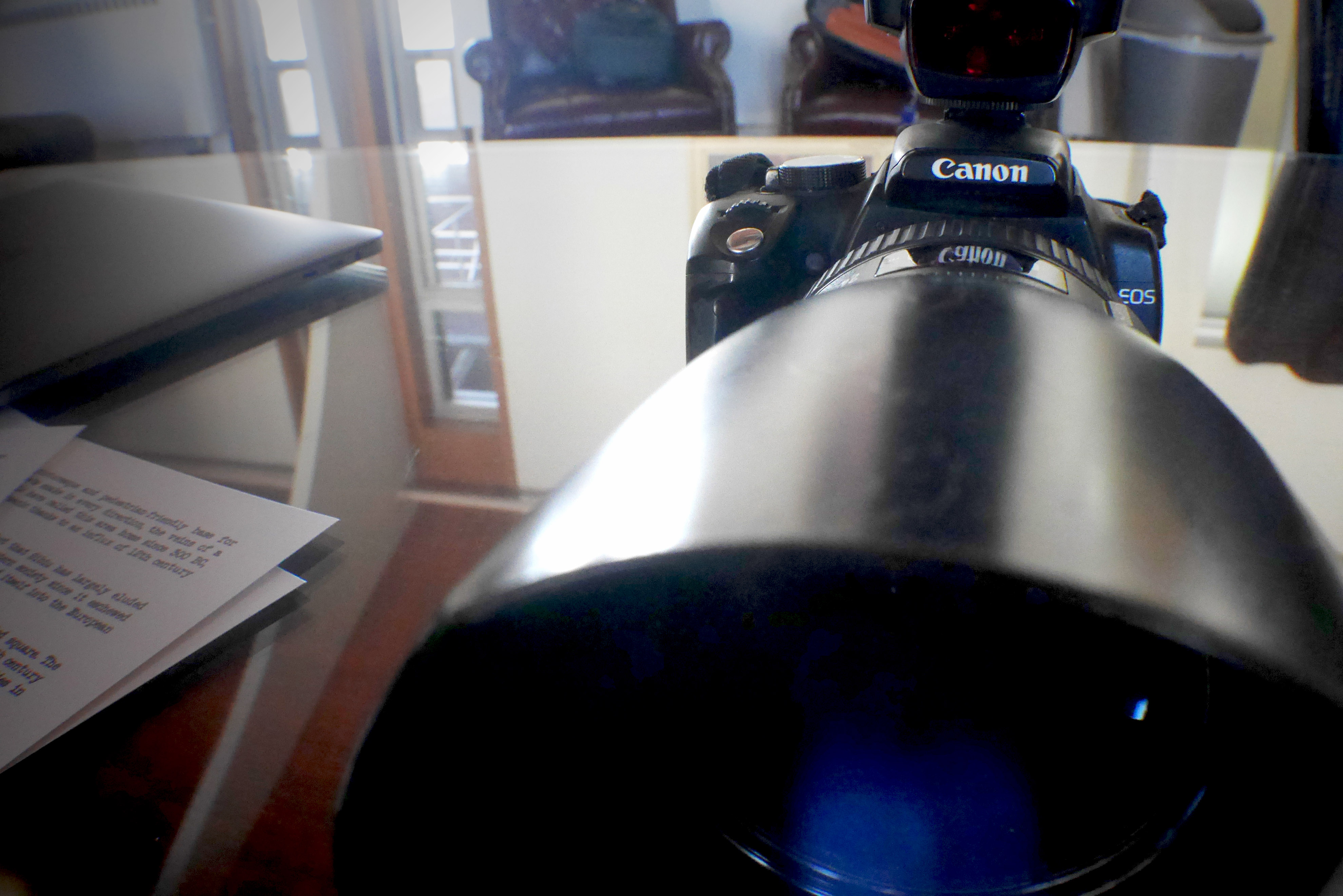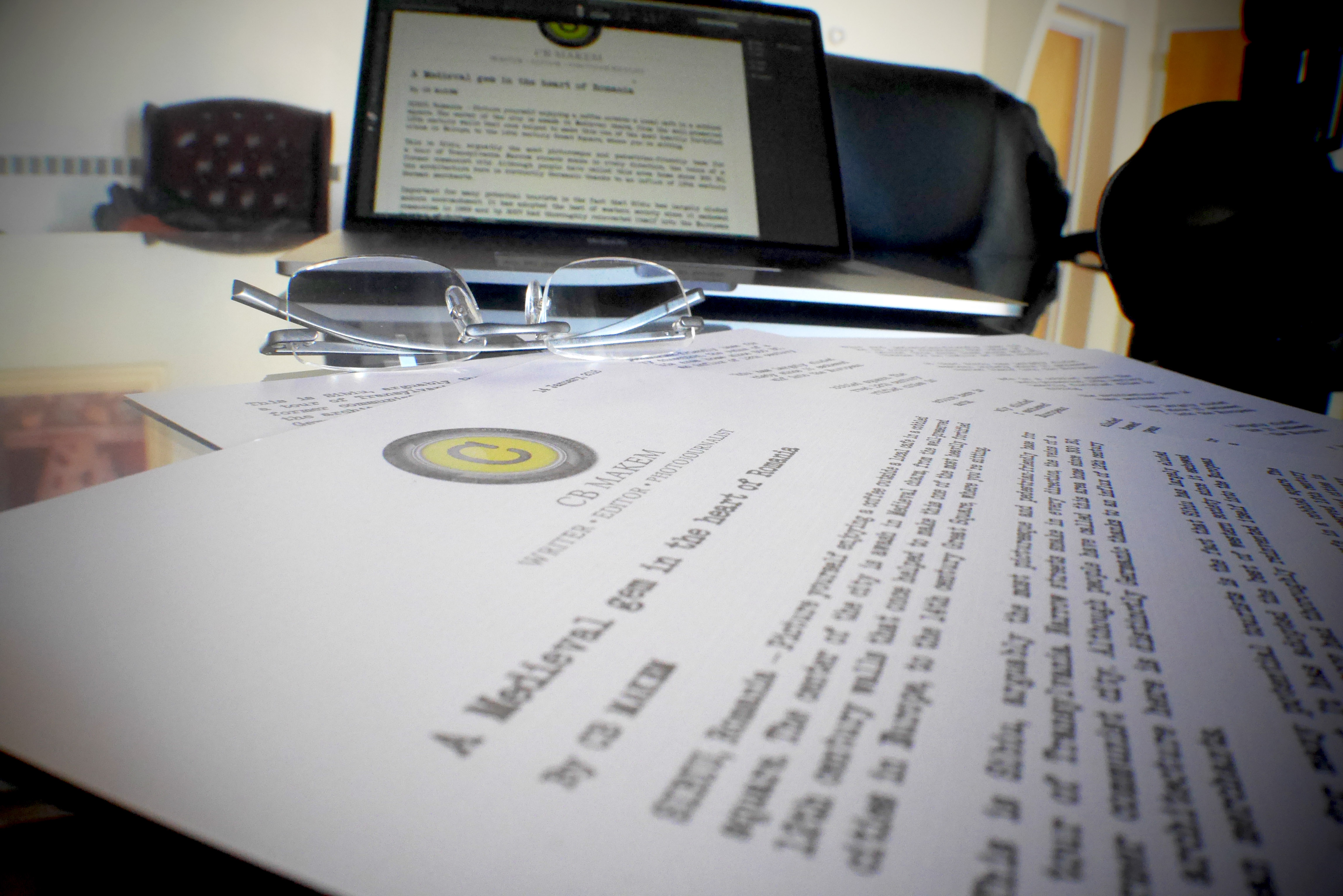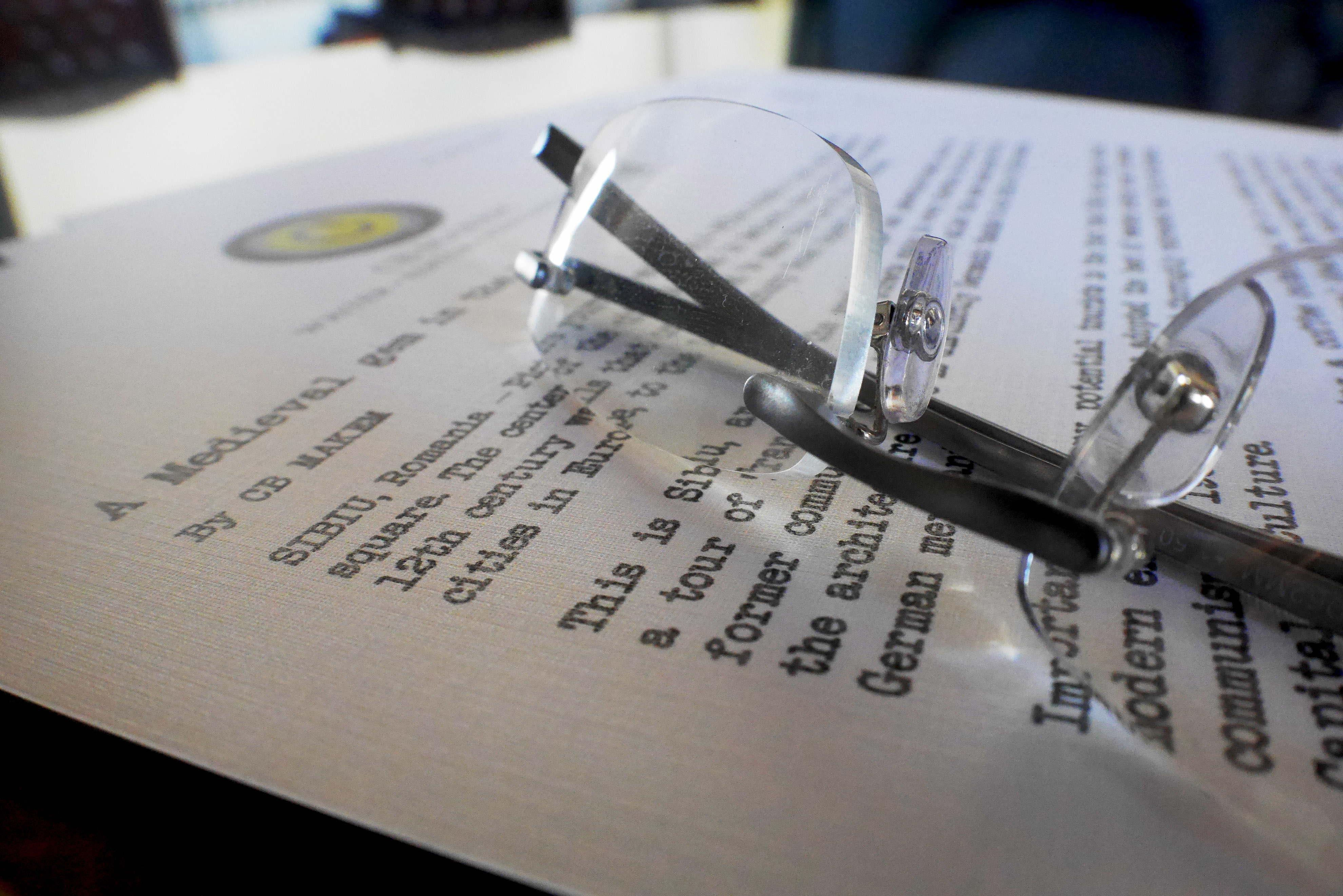A witches’ brew awaits in Salem, Mass.
Break out the pumpkin spice and don your favorite political costume. It’s that time of year again. And don’t worry about the calories. Those choco-bars are fun-sized! They’re specifically designed to be scarfed down by the dozen.
As most of you know, Halloween had its origins with the Celts, and in particular, the celebration of Samhain, the winter solstice, when the harvest was over and the long, hard days of winter were coming. It was believed to be a time when the portals to the other world were open and spirits could pass more freely between worlds.
The Witch Trials
However, you might not have had the pleasure of visiting the epicenter of ghosts and ghouls in America, probably the scariest, tackiest and yet most wonderful of all American Halloween destinations—Salem, Massachusetts. Believe me, the tourist industry aside, it’s the real deal.
Salem is famous first and foremost for the Witch Trials, which took place in 1692-93. More than 200 people were accused of being witches and warlocks and thirty were found guilty. To quote the band Rush, from their song Witch Hunt, “The righteous rise with burning eyes of hatred and ill-will. Madmen fed on fear and lies to beat and burn and kill.”
The first victim was Bridget Bishop, a sixty-year-old woman, who ran two taverns with her third husband Edward. She enjoyed wearing exotic clothes in bright colors. She was accused of bewitching five young women. To be sure, the witch hysteria had swept through Europe in the previous decades.
Bishop was hanged on June 10, 1692. She was the first of nineteen hanged that year, fourteen females and five males.
A man named Giles Corey was pressed to death on Sept. 19, 1692. He endured three days of pressing for refusing to plead guilty or not guilty. Pressing was a technique the courts used to “encourage” cooperation, where more and more weight would be piled onto the victim, who was laid on the ground. Having not pled and not being found guilty, Corey was able to pass on his land and wealth to his offspring. Otherwise, it would have become the government’s.
Scholars have argued that the gruesome way in which Corey died helped to turn the tide against the Witch Trials in public opinion.
Elizabeth Johnson Junior, who was accused, but never executed was the last of the 200 accused to be exonerated. That was due to the efforts of an eighth grade teacher and her class from North Andover, Mass…. in 2022.
Today, there’s a memorial in Salem to the nineteen who were hanged, as well as Corey, who was pressed to death. However, there were an additional five, who died in prison, likely due to torture or maltreatment. Included in those was Mercy Good, born in prison to Sarah Good, who was hanged. Yes. She was born to an accused witch in prison and died in prison after her mother was hanged. The concept is wholly unfathomable.
In 2009, a couple purchased a home overlooking a wooded ledge in Salem. They were perplexed when visitors stopped by to photograph an empty lot on the property, tucked between houses and overlooking a Walgreens. It turns out, that site was where witches were hanged and their bodies summarily dumped into a low spot beneath the ledge, known as the “crevice.”
Townsfolk in 1692 could hear relatives of the victims crying at night and carrying away the bodies of their loved ones, to be buried elsewhere.
Through a community grant and donations from descendants of the Witch Trial victims, a memorial was erected on the site.
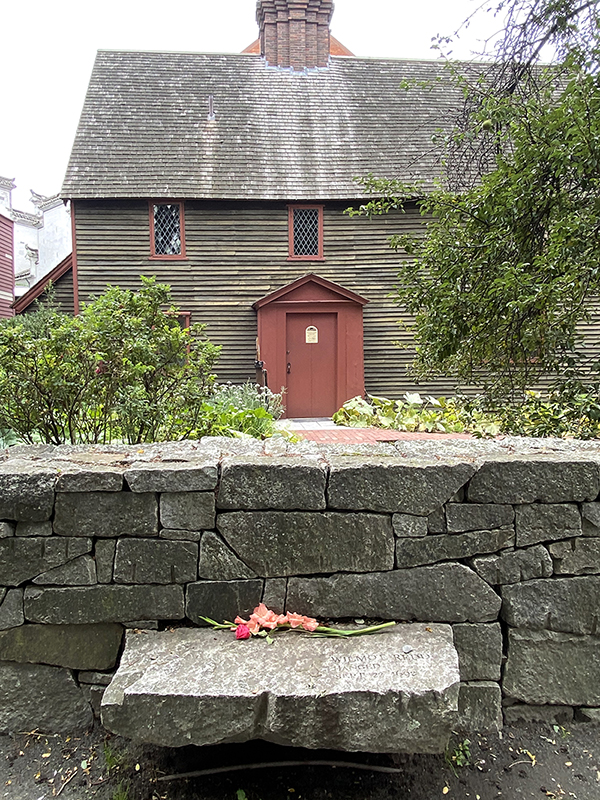
Wilmott Redd was hanged on Sept. 22, 1692, as part of the Salem Witch Trials, along with six other women and one man. It was the single most prolific execution day of the trials. Today, there is a memorial to the victims of the Salem Witch Trials, each with a plot like this one for Wilmott Redd. Five others died in prison through maltreatment or torture, including Mercy Good, who was born in prison to an accused witch, and died there.
House of Seven Gables
Aside from the Witch Trials, Salem boasts one of the country’s most famous residences, the House of Seven Gables, associated through Nathaniel Hawthorne’s novel of the same name with the supernatural and witchcraft. Some of Hawthorne’s ancestors played a part in the Witch Trials.
Originally built in 1668, the house still stands, but has been through a couple of major changes, the last of which, in 1908, restored its perceived original appearance. It is now part of a museum complex, including Nathaniel Hawthorne’s birthplace and several other period buildings.

This is the infamous House of Seven Gables, the home around which Nathaniel Hawthorne’s book of the same name was written. The novel was full of references to the supernatural. The building underwent changes through the centuries, but in 1908, it was restored to its perceived original appearance.
Around Salem
Depending on when you venture to Salem, the crowds will vary. Obviously, a trip in the latter days of October is going to be different from a week in May. Likewise, the cost of accommodations will rise during the witching season. Plan accordingly.
The town of Salem is located north of Boston and is built around the supernatural. There are all manner of psychics and witch museums, knickknack shops and historical buildings. It is also a seaport, so anyone wanting to catch a view of the Atlantic Ocean won’t be disappointed.
I’d recommend taking in the Witch Trial Memorial and the adjoining graveyard. It’s noteworthy that none of the victims are buried in the graveyard, although you’ll find judges who sentenced the poor souls to death. After having been found guilty of witchcraft, the victims were not allowed to be buried in Christian burial sites. Nobody really knows where they are buried.
If you’d like to continue on the road to introspection, the memorial located at the site of the hangings will fit the bill.
A Mick visits Vik
“There isn’t a tree to hang a man, water to drown a man, nor soil to bury a man,” said one of Oliver Cromwell’s generals. And while I couldn’t give a flying fig what any of those sociopaths thought, the quote did enter my mind as we drove through our first early hours in Iceland, the sun melting the frost off the black, volcanic rock covering as far as the eye could see—rock, as it happens, that had been strewn by forces down deep and not all that long ago.
It was like Frodo and Samwise Gamgee setting sights on Mordor for the first time, pondering if they might ever see the shire again or partake in a drink that comes in pints. In fact, I recall wanting to film a little humorous video on our phones with me as the somewhat portly sidekick to the hero of the story, ready to ferry him on my shoulders into the dreaded mountain, but the other half was quite tired and not in the mood for antics of any sort.
What, in the name of all that’s holy am I talking about? Well, as it turns out, we traveled to Iceland—the land of fire and ice—to see what it was all about. And we were not disappointed. When we landed, there wasn’t a wisp of light, it being the end of April. We landed somewhere in the region of 6 a.m. and it wouldn’t be long before the sun began to show itself. Iceland, you’ll find out, either sees a lot of dark or a lot of light. We were on the light side.
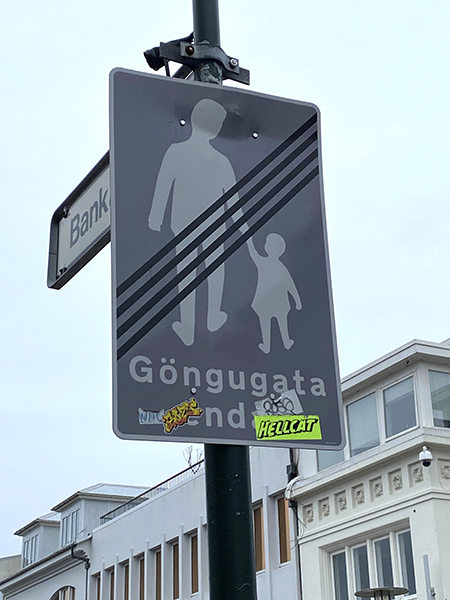
Do not mess with these people. I’m pretty sure this sign is instructing Reykjavic motorists to drive over families.
So, what was it like? What if I told you that I had the best ramen noodles of my life, felt the heat of molten lava filling up the room and sat in freezing temperatures inside natural hot spring pools by the ocean, watching birds play on the stones, the stark mountains in the distance? In a word, it was magical.
The other half and I decided that it was high time we eschewed our usual travels of shopping, eating and drinking and branch out to something more earthy, a place where we could be at one with nature, so to speak.
Our first stop, in the wee hours was the “Bridge Between Continents,” where North America meets Europe. You can stand with one foot on each continent and momentarily become king of the world (or something similar). This, I might add, was the height of Mordor, for all of you Hobbit fans.
The country was dealt a devastating blow after a volcano erupted in 2010. You might remember it. Airports around the world shut down due to ashen clouds and the economy of Iceland was in free fall. The country took on a new strategy. They tried to lure tourists with the promise of living the outdoor life and as you might have discerned, their gamble paid off. Iceland has become a huge tourist destination.
The citizens are openly appreciative, with one hotel employee in Reykjavik telling an apologetic tourist such as myself that we saved their country. What a lovely take on the situation thought I.

Iceland is teeming with waterfalls. We happened upon this one, Skógafoss, between Reykjavic and Vik.
For those of us of Irish descent, I need to make a caveat. Iceland, although it sounds an awful lot like Ireland, is most definitely not Ireland. Expect very few corner pubs. And if you’re a drinker, plan accordingly. We stayed in the picturesque town of Vik for several days and assumed that alcohol would flow as it does in most of Europe. It most certainly doesn’t. (Hint: Stock up at the airport.)
We purchased a bottle of wine at the local grocery and when we returned to our most decidedly beautiful hotel room afterwards, we were beguiled to discover how much it tasted like grape juice. The reason it tasted like grape juice is that it was grape juice. Upon further examination, we realized that there were no alcohol sales in town until Tuesday (it was Saturday) unless we wanted to make a 60-mile jaunt to a “nearby” shop. But that’s neither here nor there.
Vik lies beneath a glacier, which provides much splendor, but all that frozen water comes with a catch. When the volcano underneath said ice erupted in 1918, the majority of fatalities actually came from the rushing waters of the melted glacier and not the lava.
That gruesomeness aside, we enjoyed a lava show in Vik, which is highly recommended. The company name is a bit hard to remember…what was it again? Oh yes, Lava Show. They heat actual lava rock to 1,100 degrees Fahrenheit, then slowly ooze the lava into a darkened room of spectators, heating the vicinity up considerably. The affable representative noted that if the volcano were to erupt, all of our mobile phones would alert us to the quite unsettling fact that we had a half hour to get to higher ground. Ha ha, thought I. Wonderful stuff.
From Vik, we headed north to Geysir, where erupting waters awaited. Once again, you can imagine a Tolkien-like landscape with waters boiling on the ground and geysers erupting every few minutes. I could finish an entire column on this area, but space is short and suffice it to say, Mother Nature is awesome.
On our way out of Geysir, we stopped at Hvammsvík Hot Springs, a set of naturally heated pools, lying on the beach, overlooking the Atlantic Ocean. What a gem. After a freezing jaunt from the shower areas to the outside pools, visitors can submerge in one of eight open-air pools, the mountains and ocean offering a backdrop, and in our case, only four other people to contend with. Pure heaven. (And quite a bit less touristed than the infamous Blue Lagoon.)
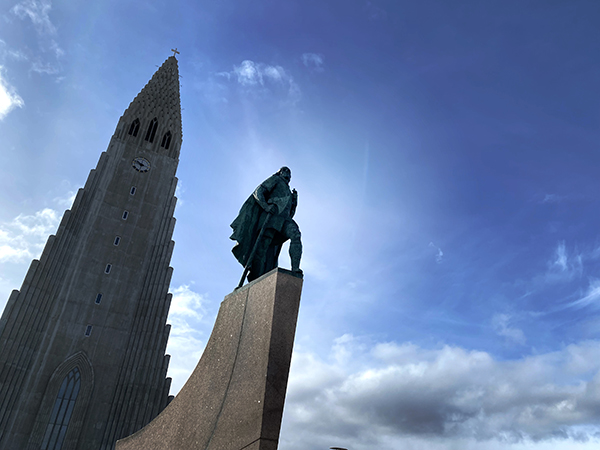
My man, Leif Erikson looking ever forward.
From there, we made straight away for the capital city of Reykjavik, with its hot dog stands and Leif Erikson statues. It’s quite a small city, but we tourists were more than happy to fill in the empty spaces. Should you try the hot dog stands? Yes. Should you visit Ramen Momo? Most definitely. Are waterfalls as common as traffic jams in the States? They certainly are.

A serving of Tantanmen from Ramen Momo in Reykjavic. This was a bowl of pure gastronomical joy.
But once again, my space here is limited. How is visiting Iceland even realistic, you ask, when Ireland awaits with all of its charm? As it happens, Icelandair allows travelers to stopover anywhere from one to seven days if they’re continuing on to Europe—for free. So you can book a flight to Dublin on the airline and choose to stop for a few days in the land of fire and ice.
What’s the downside? I don’t have an answer for that one.
Barcelona versus my ancestral home
A cousin recently returned from holidays in Barcelona, Spain with her family, raving about the sun and culture and it brought to mind my own treks through the European hotspot. It also started me thinking about the benefits of Barcelona, over her own hometown in Northern Ireland. She lives in Derrynoose, a “suburb” of Keady, Co. Armagh, so I decided to see how Barcelona stacks up against our ancestral home, a place my father referred to as the “hub of the universe.”
Ryan Air flies direct between Dublin and Barcelona, the trip only taking a bit over two hours and a cursory check on barebones prices shows roundtrip tickets at $164 for middle of the week travel.
One won’t find that kind of price from the States. A trip at the same time of year from Chicago’s O’Hare Airport to Barcelona will run you $1,152 for a nonstop flight of over eight hours. (Direct to Dublin was $668 at the time of this writing).
Comparing these two vastly different destinations is no easy task, but you’ll receive nothing but 110 percent from iIrish columnists. Let’s jump in, shall we?
I’ll start with the caveat that the great Spanish city indeed sees more sun, so I’ll give that one to Barcelona, but seeing as how my entire family goes from pale white straight to cancer, I’m fine with them having that particular title.
Sun: Advantage Barcelona
How do the populations compare, you ask? Well, here Keady has a slight advantage with a smidgen over 3,000 people, compared to Barcelona’s 1.6 million. I’ve done a quick calculation based on numbers I’m just making up, and if you stacked Barcelona’s vehicles across the entire town of Keady, you’d have a scrap of metal that reaches to the moon.
Additionally, Barcelona is jam-packed with tourists. The only tourists I’ve ever seen in Keady were ones traveling with me.
Population: Advantage Keady
Barcelona boasts more tourist sites than does Keady, so we’ll need to select a couple to compare. For Spain, I have chosen La Sagrada Família, an ostentatious church that isn’t even finished after 141 years. I think that says as much about the Spanish work ethic as anything else. Designed by Antoni Gaudí, it’s a wonderful example of the marriage of Gothic and Art Nouveau, with an impressive number of spires and probably even more pews inside.
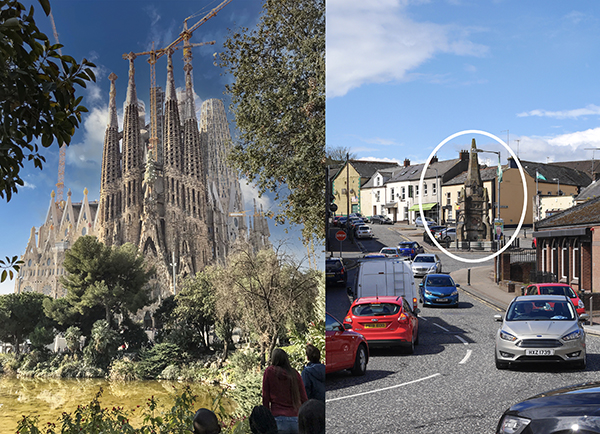
As you can see, La Sagrada Família, left, boasts a great number of spires, but the structure still isn’t finished after 141 years. The monument in Keady, right, was completed in a jiffy and has a catchy song written about it.
By comparison, the monument in the center of Keady (literally the hub of the hub of the universe) has a very catchy song written about it:
Is the monument where it used to be?
Are the boys all there?
Do the girls go skipping around the ground, where it’s nice and fair?
Is the market house where it used to be?
Sure, is everything all right?
What would I give to be with you
In Keady town tonight?
Let’s see Gaudí top that!
The monument also boasts several spires and was erected by the residents in 1871 (so even older than the Spanish church) in honor of William Kirk, who brought the linen industry to the area.
This was a tough decision, so I’m going to call this one a draw, with both monuments about equal when considered in comparison to the vastness of the universe.
Tourist sites: Draw
Unique advantages: One of my favorite television characters was Manuel, from Fawlty Towers. He was from Barcelona. Advantage Barcelona; The Tommy Makem Arts and Community Centre resides in Keady. To my knowledge, Barcelona has nothing named after my father. Advantage Keady. Likewise, my cousin, Eddie, owned a butcher shop in Keady. He never owned one anywhere in Spain. Advantage: Keady.
Speaking of Eddie, he and other family members rebuilt an old cow barn on ancestral land and turned it into arguably the best Irish session house in the world, labeling it Tossie’s. Gaudí erected Casa Milá (or La Padrera) from scratch and the architecture is world-renowned. It admittedly has more going for it visually than Tossie’s, but everyone I know who has been to Tossie’s has said they had the time of their lives. Casa Milá is just really incredible.
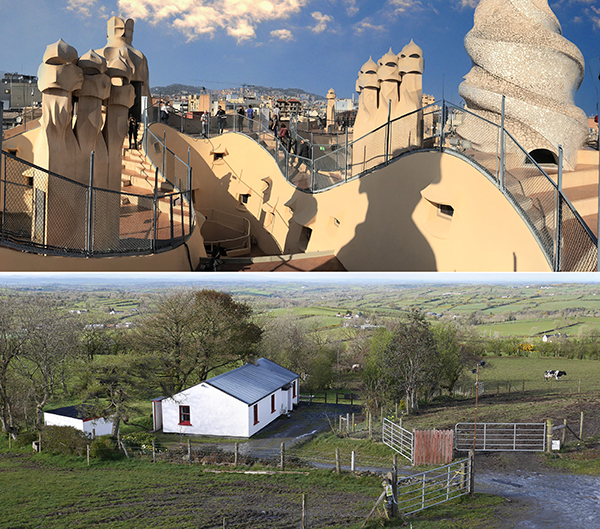
Casa Milá, top, has a slight visual advantage, but I dare you to spend a few hours in my cousins’ former cow barn, current session house, below, and not have a better time.
New/rebuilt structures: Advantage Keady (Derrynoose).
One area of contention in this great comparison is found at midday. While the people of Northern Ireland are drudging through another work day, dreaming of the time they can head home to the telly and frozen pizza, the residents of Spain are catching up on a little rest. Yes, the siesta is a real thing. Expect, even in large cities like Barcelona, to find shops and restaurants closed for a few hours so workers can recharge their batteries, so to speak.
Both Irish and Spanish cultures seem to savor nighttime, mornings not so much. The dinner crowds in both countries (I’m combining Ireland and Northern Ireland for simplicity) don’t even really start appearing until seven p.m. When I was younger, I couldn’t imagine a different way of life. Nowadays, my mind is a fog any time after eight p.m. I’ll admit that sometimes I’m jealous of those who can still remain alert into the wee hours. It’s always something I try to muscle through when visiting new places.
So as far as siestas, I suppose I’d say I’m a fan. If nothing else, it’s a wonderful example of the breadth of experiences you can have in different cultures. It’s why we travel, isn’t it?
Sleeping in the middle of the day: Advantage Barcelona
Well, I think I’ve proven that Keady and Barcelona are far more equal than it would appear at first glance. And for the record, you now know why I don’t have a job that anyone would consider “important.”
Looking back at the catastrophe that was 2022
What a long, strange trip it’s been. Twenty-twenty-two has come to a close and to celebrate, I’m offering up my memories of this tumultuous, news-laden catastrophe of a year. So, place a seat belt around your head, because I’m about to take your eyes on the ride of their life.
It’s a difficult task narrowing down a year’s worth of news stories to a single column. I could do ninety inches on the James Webb telescope without breaking a sweat, but the editor at iIrish is renowned for his hard-as-nails approach to columnists. And thusly, I must stay in my lane.
Let’s do this chronologically.
January
Prince Andrew is stripped of his military titles and charities. Irish residents, some of whom have a slight inclination away from monarchies, issue a collective yawn.
February
Russia invades Ukraine, cementing Vladimir Putin’s role as most hated person on the planet.
Piel Island, off the English coast, announces that it is seeking a new monarch. The new monarch will be in charge of the island’s crumbling castle and its 300-year-old pub. He or she must also swear an oath to be a good smoker and drinker and “to give anyone found dead on the sands free refuge in the pub.” An iIrish columnist was reputedly denied the throne.
March
Will Smith slaps Chris Rock at the ninety-fourth Academy Awards (the Oscars). It was the slap heard ‘round the world.
April
Twitter agrees to sell itself to Elon Musk. Tesla shareholders agree that it’s no big deal as long as he doesn’t offer up any controversial opinions. Wallets are then emptied out.
A scientist at the University of West England announces that he has concluded a study of mushrooms and determined that they can communicate using electrical impulses. Apparently, their vocabulary is up to 50 words, which legally allows them to hold accounts on Twitter. Willie Nelson and Snoop Dogg simultaneously nod their approval.
May
Sinn Féin becomes the largest party after the Northern Ireland Assembly elections. Several people passing by Ian Paisley’s grave claim to have heard elongated groans coming from the ground. This has not been corroborated by iIrish, but we’re working on it.
June
Nothing officially happened in June.
July
Two-time U.S. Olympic gold medalist Brittney Griner pleads guilty to marijuana charges in Russia. At that same moment, both Willie Nelson and Snoop Dogg bend over in pain sensing a strange disturbance in the force.
The James Webb Space Telescope produced its first images, stunning the scientific community. Astronomers explained the need for such a telescope, noting that since there was so little intelligent life on earth, they needed to look elsewhere. The search continues.
August
The F.B.I. executes a search warrant at Mar-a-Lago and there’s nothing I can add here from any angle that won’t flood my inbox with anger.
September
For the first time Catholics outnumber Protestants in Northern Ireland. The 2021 census showed 45.7 percent of the population are now Catholic, and 43.5 percent are protestant. Once again, several people passing by Ian Paisley’s grave claim to have heard groans coming from the ground.
Liz Truss is named the United Kingdom’s new Prime Minister. The tabloid The Daily Star announces a contest to see if she will outlast a head of lettuce. She does not. (I didn’t even have to make this one up).
In Panama, a $1.5 million prototype floating home plunges into the water during its unveiling ceremony. Simultaneously, a cutting-edge engineer is seeking “new opportunities in the job market.”
The prosecution of Soldier F resumes for the role in murdering two men on Bloody Sunday in Derry, Northern Ireland in 1972. The charges had been dropped in July 2021. The soldier also faced five counts of attempted murder.
October
President Joe Biden announces he will pardon all prior federal offenses for simple marijuana possession. Willie Nelson and Snoop Dogg spontaneously erupt in muffled giggles.
The other half and I traveled to Denmark and Sweden. This isn’t a tidbit you’re likely to run across in the New York Times or on the BBC, but iIrish delves a little deeper into some subjects than those rags. Feel free to peruse my column on the trip in this esteemed journal, which pitted Denmark against Ireland, with some remarkable results. Take that, so called other news outlets!
November
The midterm elections surprise pollsters and lead everyone in the country to ask why anyone pays attention to polls anymore.
December
Experts declare the latest Covid variant XBB.1.5 is spreading like wildfire, leaving people worldwide excited for 2023, because it can’t get any worse. Can it?
It's the Irish/Danish smackdown
Sure, it consistently ranks as one of the happiest countries on the planet, but what does Denmark have that Ireland doesn’t? Well, for one thing, they have a royal family, which obviously isn’t anything to be envied, but the differences don’t stop there, oh no they don’t dear reader.
So, having just set foot back home in Amerikay from a quick trip over to the Land of Danes, I will now provide for you a full comparison of the two countries, which I’m sure upon completion of this column you’ll agree is both accurate and all-encompassing. This won’t be pretty. You should be prepared to roll around in the mud with this article, but in the end, I think you’ll walk away wiser.
Chocolate bars: Advantage Ireland.
Let’s jump into the meat of the debate, shall we? One of my guilty pleasures when visiting a country for the first time is delving into their junk food. That’s a huge part of the culture, isn’t it, the potato crisps and choco bars? I’m going to come clean and admit that I don’t speak Danish and, if you’ve tried to learn it, you’ll understand why I stopped trying. It’s a tongue twister (much like Irish) with words that are pronounced very differently from how they’re spelled (much like Irish). The best I could do was to visit the Irma shop and look for the good stuff.
On my first attempt, I settled on the Tyrkish Peber and the Pepe XXL. Both looked like respectable chocolate bars, the Tyrkish Peber with illustrations of flames coming out of the chocolate, which was intriguing. Upon returning to the hotel room, I ripped open the new delectables and chomped down on licorice…not chocolate.
Good people, I ask you, what nation of happy people disguise their licorice as chocolate and claim to still be happy? Their version of the Rolo was admirable, but the licorice was beyond the beyond.
Potato chips: Advantage Ireland.
On that first fateful trip, I also purchased a bag of Iberian ham potato crisps. Not so bad, I didn’t think. Quite like kettle cooked chips and certainly reminiscent of Iberian ham, I was content. Was I content enough to eschew my Tayto Cheese and Onion? Not on your life.
Bicycles: Advantage Denmark.
Next, we move to environmental issues. I was pleasantly surprised to see a complete void of plastic utensils. From the street vendors to the food markets, wooden spoons and forks abound. Likewise, the nation is awash in bicycles. At any Copenhagen stoplight, you’re likely to see as many or more bicycles as motorized vehicles. Ireland has bikes, but Denmark is bicycle Utopia.
Pastries: Advantage Denmark.
This one’s almost a no-brainer. Ireland has some lovely pastries. I mean, is there a person on the planet who doesn’t love sinking their teeth into shortbread biscuits? But, good people, consider the Danish. The danged word is synonymous with the country. They don’t call them Danish in Denmark, they call them pastries. And they’re goooood.
Tea: Advantage Ireland.
Denmark is not the black hole of easily accessible good tea like the United States, but a plain old cuppa does not grow on trees, like it does in Erin. Nose in the uppity direction.
Background music: Advantage Denmark
Let’s face it, we’ve all been there. You stop into a quiet little pub in a quaint Irish village and as soon as you’re settled, you realize that the music over the background speakers was selected by a twelve-year-old. It’s a phenomenon that to this day I can’t explain. Ireland is home to some of the best music the planet has ever known and yet, if you were to visit just about any public place in the country, you wouldn’t know it. It’s like businesses have decided that bubblegum pop is the only option, that adults don’t care about music, so let’s just please the wee ones.
Denmark had some of that, but on a whole, when you enter an establishment, you feel like there’s an adult in charge of the music.
Castles run by fictitious Danish Kings: Advantage Denmark.
We visited Kronborg Castle (aka Hamlet’s Castle) in Elsinore, Denmark. There’s really no competition on this one. I don’t think Ireland even has one of these.
Border Crossings: Advantage Denmark.
While I’ll admit that crossing between Monaghan, in the Republic and Keady, Co. Armagh, in the North, via the now derelict British Army barracks is a tonic, the five-mile train bridge between Copenhagen and Malmö, Sweden, spanning the sea edges out the competition. Bravo Nordic countries. Bravo.
Pedestrian Shopping Streets: Draw.
It’s pretty darned difficult to top Grafton Street for pedestrian-friendly shops and restaurants, but the Strøget in Copenhagen’s historic district, will reel you in with its equally car-free and mobbed walkways. There’s just no clear winner.
Happiness: Advantage Denmark.
Alas, this one wasn’t up to me. Ireland ranks pretty high on happiness rankings based on any number of criteria, but the Danish are consistently among the happiest people in the world. Maybe it’s the Irish tendency to center life around alcohol, or their choice of pop music in public places…or perhaps it’s the preponderance of bicycles keeping people active and fit in Denmark, but whatever it is, kudos to them.
Flights: Advantage Ireland.
Our direct flight from Boston to Copenhagen was cancelled an hour before we were set to take off. And since we didn’t want to be saddled with a case of Coronavirus as we began our week in Denmark, we donned masks for the journey. The airline, through much confusion and consternation (and much is not a strong enough word) booked us on another airline through Portugal and onto Copenhagen twelve hours later than we had planned, thus essentially cutting a day off of our holiday. I’ll add that we were wearing masks for twenty-four hours. With the caveat that Aer Lingus brings us into Dublin from Boston at an ungodly early hour, they’ve never cancelled a flight on me.
Irish Pubs: Advantage Ireland.
There were an unusually high number of Iris pubs in Copenhagen, but let’s be honest. There are more in Ireland.
Danny Kaye Songs: Advantage Denmark.
For weeks leading up to our Danish trip—nearly on a daily basis—the old Danny Kaye standard “Wonderful Copenhagen” was rattling around my brain. It continued through our stay and even for days after returning. I’ll admit that no Danny Kaye song has done that to me any time I’ve spent in Ireland. Who knew?
And there you have it, a complete and unvarnished comparison between Ireland and Denmark the likes of which you’re not likely to find in any periodical outside of iIrish. Put it another way, Denmark is well worth a visit.

Ok, I'll concede that Denmark has better castles run by fictitious Danish kings than does Ireland.
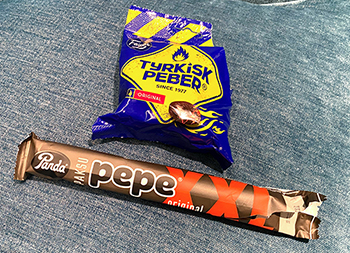
Be forewarned. Neither of these is chocolate.
Want to know a culture? Check out their groceries.

Hear me out. I know that to understand Irish culture, you need to visit the pubs, but for me, the most underappreciated establishment for any culture is the grocery store. It’s the commonality between almost everyone in every country around the world.
Roam the aisles and cast your eyes on the foreign variety of biscuits and beer, frozen foods and chocolate bars. I absolutely love experiencing the local Lidls and Tescos, the Carrefours and Aldis. Food is at the heart of every culture and these shops are where your average Juan and Maríah Sixpack grab their essentials.
I’d argue that you learn as much about a culture by visiting their food marts as you do from their museums. Sure, museums will teach you their history, but the grocery store will tell you who they are.
Among my favorite pastimes in Ireland, for example, is to hit the petrol stations and peruse the sheer volume of crisps: gammon and cheese; scampi; buffalo; Irish stew; Wuster sauce; chorizo and cherry tomato; bacon and cabbage. It seems endless and that’s before considering the styles like chipsticks, hula hoops, potato puffs and waffles.
And it’s not just what the stores stock, it’s what they don’t. I searched high and low through store after store in Romania before I found a container of maple syrup. It made me appreciate not only the different offerings they stocked, but what I had back at home. Speaking of which, I’d like to offer a shout-out to the cashier lady at our local Carrefour in Sebeș, Romania. For three months, the other half and I saw her almost every day and not once did she crack a smile. After months, the shop’s security officer wouldn’t stop following us around through the aisles. I wanted to pull him aside and explain that Libby and I probably spent as much in the store as a family of eight. But I digress.
Anyhoo, a grocery store will tell you what the average home puts on their plates day after day. In Spain there’s plenty of rice and seafood, in Germany, local sausages and infinite beer, in Puerto Rico, tropical fruits and corn flour.
I was in a small shop on the island of Curacao. The shop wasn’t busy at all, but there were four lanes, each with cashiers and baggers. There was no waiting. I zipped through. When I made an off-hand remark to one of the locals in the parking lot, he informed me that that’s common down there.
Conversely, he said, you can’t always find what you want. There might be days without salsa, or seasons where certain produce just isn’t available. One just needs to be ready to adjust based on the offerings. It dawned on me that that’s not the worst thing.
There was a child running a corner store in Córdoba, Spain, probably ten-years-old. I was looking through packages of biscuits and she pointed to a container of butter cookies, a selection I likely wouldn’t have chosen. But she was right. I brought them home and Libby and I devoured the entire package with cups of tea.
Are international flights not in the cards for you? Not to worry. The offerings in the southwest are quite different from the northeast, from dried hatch chilis to local wines to beef tongue. One of my favorite shops is in Abiquiú, New Mexico. Called Bodes General store, it serves a small community of 231. It’s a gas station that sells just about everything you can imagine, from cattle feed to hats, local wine to frozen meals.
There’s a food takeout window inside Bodes where you can grab a cup of chili or freshly made tamales, load up on their baked pastries and snack as you drive past craggy red rocks and desert. It’s an experience, let me tell you.
And for those of you not in a traveling mood, may I suggest you make use of import shops and Irish bakeries, some of which you can find advertising in iIrish. If you’re new to Irish cuisine, here are some of the items it is compulsory to start with: Tayto Cheese and Onion crisps, Irish sausages, vegetable soup, Cadbury Dairy Fruit and Nut bars, and Smarties. I’m not saying you want to make a diet based on these things, but…well, if you add potatoes, you should be okay.
